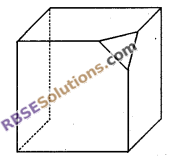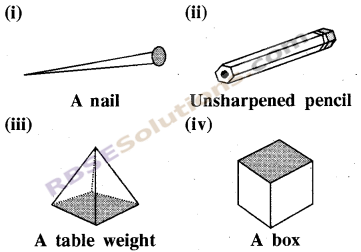RBSE Solutions for Class 8 Maths Chapter 8 Visualization of Solids Additional Questions is part of RBSE Solutions for Class 8 Maths. Here we have given Rajasthan Board RBSE Class 8 Maths Chapter 8 Visualization of Solids Additional Questions.
| Board | RBSE |
| Textbook | SIERT, Rajasthan |
| Class | Class 8 |
| Subject | Maths |
| Chapter | Chapter 8 |
| Chapter Name | Visualization of Solids |
| Exercise | Additional Questions |
| Number of Questions | 37 |
| Category | RBSE Solutions |
Rajasthan Board RBSE Class 8 Maths Chapter 8 Visualization of Solids Additional Questions
I. Objective Type Questions
Question 1.
Plane figures are called
(a) multi-dimensional
(b) three-dimensional
(c) two-dimnsional
(d) none of the above
Question 2.
Number of vertices in a cuboid are
(a) 12
(b) 8
(c) 6
(d) 4
Question 3.
Every solid shape is made(RBSESolutions.com)up of various two dimensional figures. These are called
(a) edges
(b) vertices
(c) faces
(d) cuboid
![]()
Question 4.
Euler’s formula is
(a) F + V = E + 2
(b) F – V = E – 2
(c) V + E = F + 2
(d) V – E = F – 2
Question 5.
The point where the edges of a solid, is called
(a) face
(b) surface
(c) vertex
(d) pyramid
Question 6.
An example of three dimensional figure is
(a) cuboid
(b) circle
(c) square
(d) rectangle
![]()
Question 7.
Number of faces in a cuboid are
(a) 6
(b) 8
(c) 12
(d) 10
Question 8.
Number of edges in a cube are
(a) 8
(b) 12
(c) 6
(d) 14
Question 9.
Number of faces in a cube
(a) 12
(b) 8
(c) 6
(d) 10
Answers
1. (c)
2. (b)
3. (c)
4. (a)
5. (c)
6. (a)
7. (a)
8. (b)
9. (c).
![]()
II. Fill in the blanks
Question 1.
Cuboid is a___shape.
Question 2.
3D objects will have___views from different angles.
Question 3.
For any polyhedron, F + V =___ is true.
Question 4.
There is no reference or perspective in a ____
![]()
Question 5
___is very important(RBSESolutions.com)for drawing a picture but it is not relevant for a map.
Answers
1. three-dimensional
2. different
3. E + 2
4. map
5. Perspective.
![]()
III. Very Short Answer Type Questions
Question 1.
Write number of edges and faces in a triangular prism.
Answer
Number of edges in a triangular prism = 9 and number of faces in a triangular prism = 5.
Question 2.
What are two dimensional shapes?
Answer
The plane figures(RBSESolutions.com)having two measurements, length and breadth, are called two dimensional shapes.
Question 3.
Give 3 examples of two dimensional shapes.
Answer
Triangle, rectangle circle etc.
![]()
Question 4.
Give 3 examples of three dimensional shapes.
Answer
Cuboid, sphere, cylinder etc.
Question 5.
What is the definition of Prism?
Answer
A prism is a polyhedron(RBSESolutions.com)whose base and top are congruent polygons and whose other faces, i.e., lateral faces are parallelogram in shapes.
Question 6.
What do you mean by pyramid?
Answer
A polyhedron having a polygonal base and triangular sides with a common vertex, is called a pyramid.
![]()
Question 7.
Find the number of faces in polyhedron having vertices 10 and edges 16.
Solution
Number of vertices (V) = 10, Number of edges (E) =16, Number of faces (F) = ?
Euler formula V + F = E + 2
⇒ 10 + F = 16 + 2
or F = 16 + 2 – 10 = 8
Question 8.
Define a regular polyhedrons.
Answer
A polyhedron is said to be(RBSESolutions.com)regular if its faces are made up of regular polygons and the same number of faces meet at each vertex.
Question 9.
Is it possible to have a polyhedron with any given number of faces?
Answer
Yes, it is possible only if the number of faces are greatest then or equal to four.
![]()
Question 10.
Is a square, prism same as a cube? Explain.
Answer
Yes, It can be a cube. But it can be a cuboid also.
Question 11.
Can a polyhedron have(RBSESolutions.com)10 faces, 20 edges and 15 vertices?
Answer
Since, F + V = E + 2
As 10 + 15 ≠ 20 + 2
∴ A polyhedron cannot have 10 faces, 20 edges and 15 vertices.
![]()
IV. Short Answer Type Questions
Question 1.
One vertex of a cube in cut equidistant from her three sides as shown in fig. How many faces and vertices in new fig.

Solution:
Number of faces (F) = 7
Number of vertices (V) = 10
Question 2.
Can a polyhedron have for its faces
(i) 3 triangles?
(ii) 4 triangles?
(iii) a square and four triangles?
Solution
We know that polyhedron is a solid, which is bounded by four or more polygonal faces in such a way that pairs of faces meet along edges and three or more edges meet in each vertex, therefore,
(i) It is not possible(RBSESolutions.com)that a polyhedron has 3 triangles for its faces.
(ii) 4 triangles can be the faces of a polyhedron.
(iii) A square and 4 triangles can be the faces of a polyhedron.
![]()
Question 3.
Which are prisms among the following?

Solution
We know that a prism is a polyhedron whose base and top are congruent polygons and lateral faces are parallelogram. Therefore,
(i) A nail is not a prism.
(ii) An unsharpened pencil is a prism.
(iii) A table(RBSESolutions.com)weight is not a prism.
(iv) A box is a prism.
![]()
Question 4.
(i) How are prisms and cylinders alike?
(ii) How are pyramids and cones alike?
Solution
(i) A prism becomes a cylinder provided the number of sides of its base becomes large and larger.
(ii) A pyramid becomes a(RBSESolutions.com)cone provided the number of sides of its base becomes larger and larger.
Question 5.
Using Euler’s formula find the missing numbers.
| Polyhedron | Face | Vertex | Edges |
| A | ? | 6 | 12 |
| B | 5 | ? | 9 |
Solution
For A Polyhedron
Number of faces = ?;
Number of vertices = 6,
Number of Edges = 12
By using Euler’s formula
F + V = E + 2
or F = E + 2 – V = 12 + 2 – 6
F = 14 – 6 = 8
∴ Number of faces F = 8
For B Polyhedron
Number of faces = 5;
Number of vertices = ?,
Number of Edges = 9 ,
By using Euler’s formula
F + V = E + 2
or V = E + 2 – F = 9 + 2 – 5 = 6
∴ Number of vertices = 6
![]()
Question 6.
Find number of edges in a polyhedron which have 9 vertices and 9 faces.
Solution
Number of vertices (V) = 9
Number(RBSESolutions.com)of faces (F) = 9
To Find : Number of edges.
Euler’s formula : V + F = E + 2
Then, 9 + 9 = E + 2
or 9 + 9 – 2 = E
Hence, E = 16
Question 7.
In a polyhedron, number of faces is 5 and number(RBSESolutions.com)of edges is 9. Find the number of vertices.
Solution
Number of faces (F) = 5
Number of Edges (E) = 9
Number of Vertices (V) = ?
We know by Euler’s formula
F + V = E + 2
5 + V = 9 + 2
5 + V = 11
V = 11 – 5
V = 6
∴Number of vertices = 6
![]()
We hope the given RBSE Solutions for Class 8 Maths Chapter 8 Visualization of Solids Additional Questions will help you. If you have any query regarding Rajasthan Board RBSE Class 8 Maths Chapter 8 Visualization of Solids Additional Questions, drop a comment below and we will get back to you at the earliest.